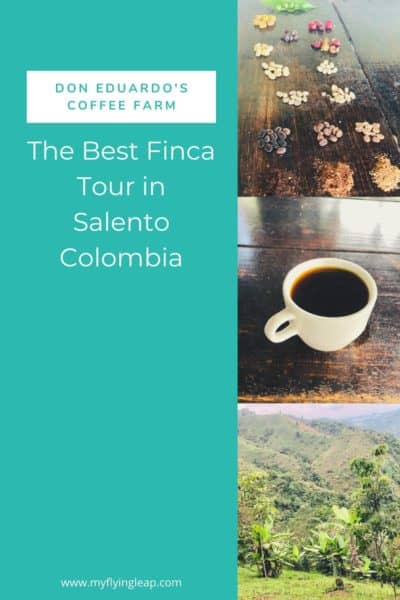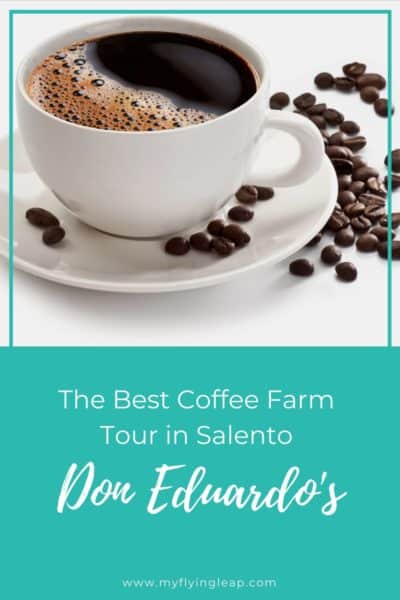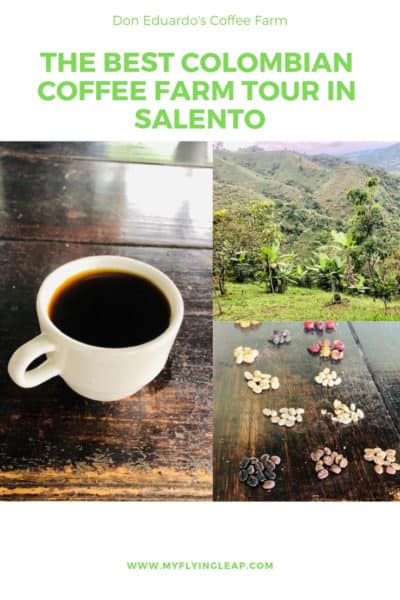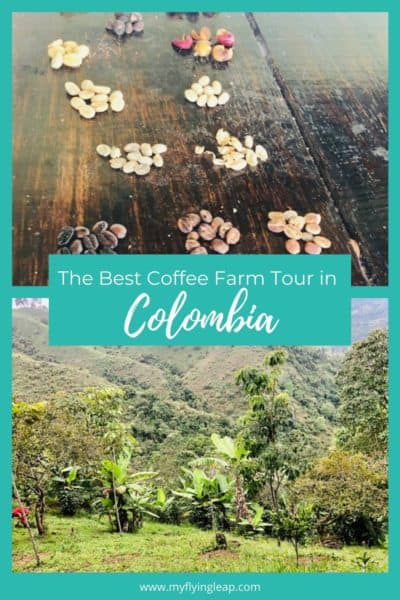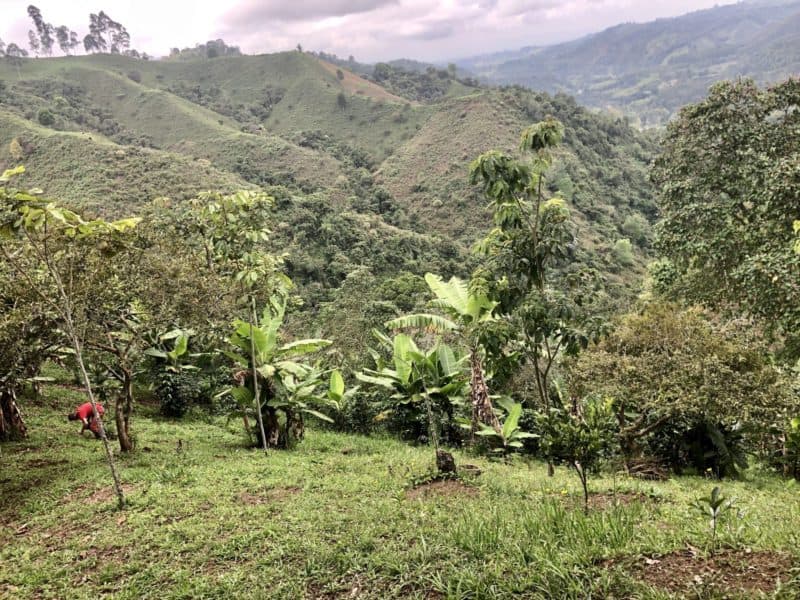Best Salento Coffee Tour—Top Family-Owned in Salento, Colombia
Don’t miss the opportunity to learn about your cuppa Joe when visiting Colombia. If you’re looking for the best Salento coffee tour with a small, family-owned finca in Salento, look no further than Don Eduardo!
There are many fun things to do in Salento, Colombia. While you’re in the heart of coffee country, home to some of the best coffee in the world, it’s a great idea to tour a Colombian coffee farm to try some of the best Colombian coffee. It’s almost a requirement to visit Colombia!
Colombia is one of the world’s largest coffee exporters to the United States. The best Colombian coffee beans are exported, and Colombia gets the remainder. Typically, Colombian coffee is best enjoyed outside of Colombia.
Here’s what you’ll want to know about visiting a Colombian coffee plantation and the best Salento coffee tour you won’t want to miss.

Some links in this article may be affiliate links, which means that if you purchase through them, I receive a small commission. This will never cost you extra. Please read the disclosures to learn more.
Quick Facts About the Don Eduardo Salento Coffee Tour
- Location: Plantation House Hostel, five minutes from the center of Salento
- Tours: Every Monday through Friday in English at 9 a.m. and in Spanish at 3 p.m. On Saturday, there is an English tour at 9 a.m.
- Reservations: You can book a reservation at the Plantation House Hostel online. Tours can be arranged at the office once you arrive.
- Contact: [email protected]
About the Colombian Coffee Industry
Colombia is the country with the third-largest coffee production in the world, behind Brazil and Vietnam. Colombians don’t have much history of drinking coffee, which is really interesting considering what a significant crop it is to their economy.
Colombia has always exported most of the coffee produced. It’s a huge crop for the country and generates significant revenue.
Much of the country has a climate for growing coffee with rich volcanic soil and a substantial rainy season. There are many large-production farms as well as smaller boutique Colombian coffee farms that really focus on quality.
Why Go to Salento for Colombian Coffee Farms?
La Zona Cafetera (Eje Cafetero) is an ideal place for coffee production, with rich volcanic soil, a wet climate, and topography. Salento sits in the heart of the region and has a number of coffee farms that you can tour.
The Coffee Triangle (Zona Cafetera) is also a UNESCO World Heritage site. It’s a special place to visit, and Salento is a wonderful reflection of this beautiful and diverse region. It’s the best of the Colombian coffee regions in the country.
There are a number of Colombian coffee farms in Salento that you can visit. They offer tours with coffee tastings where you can learn more about their growing process and their coffee. They’re a great place to learn about the area, as well.
I read posts about several of the
Also, Don Eduardo’s offers a three-hour tour. So, I knew we would really get an education about coffee production. I was so glad I did!
You May Also Like Top 10 Things to do in Salento Colombia
All About the Finca Don Eduardo Salento Coffee Tour
The original Plantation House is over 100 years old. However, the yield in high elevations is low, so much of the property was sold off as real estate. There is now a hostel on the property with multiple buildings. The finca, or farm, is a ten-minute walk from the buildings where I stayed.
The start of the tour is across a dirt road from the Plantation House Hostel. This tour goes into depth about everything about coffee, from the growing process to the product that you enjoy in your cup and everything in between.
When you’re done, you have a real appreciation for the process and effort that goes into your cup of joe. Especially so for a small boutique eco-farm like Don Eduardo.
Don Eduardo
Tim, the owner of Finca Don Eduardo and the Plantation House Hostel, is an expatriate from England. He, along with his Colombian wife and two daughters, run the farm and hostel. They established the first Western-style hostel in town. Tim, you ask? Then who is Don Eduardo? It was the name he adopted for the farm, as it has more of a Colombian sound to it.
Tim is passionate about all things coffee: the beans, the planting and cultivation process, roasting, and tasting. He is very interested in producing a high-quality product and recognizes that it makes him less money. “I might be crazy,” he said, but it’s all about the quality of what ends up in the cup that really matters to him.
His farm is organic, but he proudly labels his bags of coffee as “deliberately uncertified organic coffee.” They use organic fertilizer bio-mixes, including garlic and chili, mineral oil, unscented soap, and alcohol for pest control. He also plants tobacco near the coffee plants as the insects eat those instead of the coffee.
Tim employs other eco-friendly methods as well by catching and using rainwater and using some solar power. This farm’s process is well thought out, and they continue to strive to learn and develop improved practices.
Introduction to All Things Colombian Coffee
Accompanied by several family dogs, including a giant Newfoundland puppy named Stanley and a donkey named Houdini, we sat with Don Eduardo, who shared his passion and extensive knowledge of the coffee industry.
There are two primary types of coffee grown:
There are over 100 varietals that are segmented as traditional, heirloom, and modern. Modern was developed in a lab, though they are not genetically modified.
Don Eduardo grows all traditional coffee and is the only grower in the area to do so. Traditional coffee plants can get as tall as 10 meters (almost 33 feet). They are planted two meters apart for picking distance, and the top is chopped off so they grow outwards. These coffee plants prefer shade, so he plants taller bananas and plantains to provide that.
Modern coffee plants don’t require shade, they don’t grow as tall, and they are more resistant to pests. They produce more coffee with bigger beans, which in turn provides more income from the crop. But that’s not the way things are done around here.

Colombian Coffee
There is no world standard for coffee, so it’s subjective in terms of quality. There is a standard for the sizing of the beans. Don Eduardo Coffee Farm focuses on quality traditional beans.
Coffee grows year-round and is usually picked when it is ready during the rainy season, where 85% is picked in October or November and 10% is picked in May. At Don Eduardo’s Colombian Coffee Farm, it’s the opposite, where the majority is picked in October and November.

The colors of the beans turn colors from red to yellow to orange and finally dark burgundy, indicating they are ready. Once a bean is removed from the tree, no further beans will grow in that spot.
Walk the Finca Grounds
It’s a ten-minute walk to the Finca, which is on an impressively steep incline, especially when you consider that much of the picking is done during the rainy season.
We walked a loop down a very steep area to enjoy the view, see the various plantings, and consider just how steep it is and that the picking season is when it’s raining. I can’t even imagine not sliding right down that steep descent.
There was an area of bamboo and even some pineapples near the path. Everything grown is used or sold. In addition to coffee, the farm plants bananas, plantains, avocados, mandarins, tea, lemons, pineapple, and other items.

Don Eduardo’s Colombian Coffee-Growing Process
There are many steps in the growing process. First, rinsed and dried coffee beans are placed in river sand to seed, which takes the beans around two months to start growing.
Then, the sprouts are transplanted individually with compost in a small black bag and then planted in the ground. It generally takes around three years for the plant to flower and nine more months to be ready to harvest, a total of four years and two months before it is ready to pick!
A machine is used to separate the skin from the beans, and then they are soaked in water to remove a sweet layer and to test the coffee beans. They go through several soaks before this is complete. If the bean floats, it is tossed.
Only beans that sink move forward in the process to ensure quality. If more than 20% of a crop floats, they set out to investigate the issue with the crop. Last, they are laid out on concrete to bake in the sun. The all-natural way of roasting Colombian coffee.


Don Eduardo Colombian Coffee Farm
We were ready for a tasting. There were six small cups laid out, with a light roast, a dark roast, and a medium roast, and either traditional or modern beans.
We got to try them all and discussed the differences that we tasted between the different cups. After we all tasted it, we got to select which one we wanted them to brew for the group. We chose
Then, we were shown the last parts of the process of removing the husks, grinding the beans, and roasting them on a large metal pan on the stovetop. As the beans grew darker, the smell was released, and we could anticipate how wonderful it was going to taste.
The final cup did not disappoint, and it was a really great cup of coffee.


Added bonus: if you’re an animal lover, there is a very friendly dog and a cat who are often in the tasting area to keep you company.

Plantation House Hostel
The family owns the Plantation House Hostel, and I recommend this for accommodation when visiting Salento. This hostel has shared dorm rooms and some private rooms as well, with private baths.
It’s a 5-10 minute walk from the town square and the main street, Calle Real, so it’s very quiet. The family is wonderful and makes you feel very welcome.
They even invited me to a bonfire on my first night, which is where I met a number of people from Europe and South America that I hung out with during my stay in Salento.
Tours are held every Monday through Friday in English at 9 a.m. and in Spanish at 3 p.m. On Saturday, there is an English tour at 9 a.m.
You can book a reservation at the Plantation House Hostel online. Tours can be arranged at the office once you arrive.
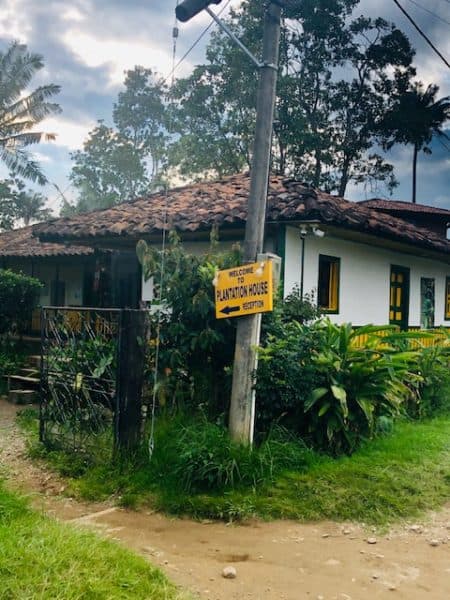
Visiting Salento, Colombia
Salento is a small town located in the heart of the Coffee Triangle (Eje Cafetero) region of Colombia. This colorful town is part of a UNESCO World Heritage Site called “The Coffee Cultural Landscape of Colombia” and has retained its old-world charm with a distinctly laid-back attitude.
Salento is a common vacationing spot for Colombians. As a result, it can get crowded, especially on the weekends.
There are a lot of fun things to do in and around Salento, and it is a refreshing place to recharge from visiting the larger cities of Cartagena, Medellin, and Bogota.
From epic hikes through the rainforest in Cocora Valley to enjoying the quiet side of Colombian life, it’s really worth visiting. It provides a really beautiful place to compare the larger cities to.
How to Get To Salento
Most people take a bus from Medellin to Salento, which takes around 6-8 hours but can take more, depending on road conditions. Flota Occidental is the company that runs this bus.
The bus leaves from Terminal del Sur in Medellin, and as of this writing, the scheduled times are 9 and 11 a.m. and 1 p.m. Times may change, so be sure to check the schedule. A one-way ticket costs around $13 USD (47k COP).
Salento is also accessible by bus from the cities of Armenia and Perreira, and there are flights from Medellin that will take you there. There is no airport in Salento. You can get flights as low as around $75 for a one-way ticket, then take the bus from either Armenia or Perreira.
Is Colombian Coffee the Best in the World?
Colombian coffee is believed by many to be the best coffee in the world. It’s certainly a popular type of coffee around the world, so who can argue? Coffee tourism is big in Colombia, especially in this region.
There are some large growers, though, in Salento, most of the coffee plantations are smaller growers. It provides a new perspective on your morning cup, knowing where your beans came from and how they are cultivated.
A coffee tour in Salento is a great way to learn more about the coffee industry, the coffee growers, and the coffee beans. The Don Eduardo Coffee Farm offers a great tour and really good beans that you can take home to enjoy as a reminder of your trip.
Should You Go on Don Eduardo’s Colombian Coffee Farm Tour?
I highly recommend Don Eduardo’s Coffee Farm Tour if you really want to learn about coffee production. The tour costs 30k COP ($9.50 USD), not inexpensive by local standards. However, it’s discounted
Tim is passionate about coffee, as are his daughters. They make this tour really interesting, and you’ll learn a lot about Colombian culture, coffee production, organic growing, and living in small-town Colombia. If you’re going to go on a Salento Coffee tour, I do recommend this one.
Is this the best Colombian coffee? Try it to find out!
You Might Also Like
- A Traveler’s Guide to the Best Places to Visit in Colombia
- 21 Best Things to Do in Cartagena
- Best Day Trip from Cartagena—Palenque de San Basilio
- Colombia Travel Tips—25 Things to Know Before You Go
- Best 11 Things to Do in Medelliín
- The Most Colorful City in Colombia—Guatapé
- Top 11 Fun Things to Do in Bogotá
- Best Day Trip from Bogota—Zipaquira and the Salt Cathedral
- Top 10 Things to Do in Salento Colombia
- Hiking Cocora Valley—The Top Thing to Do in Salento
Like it? Pin it!
